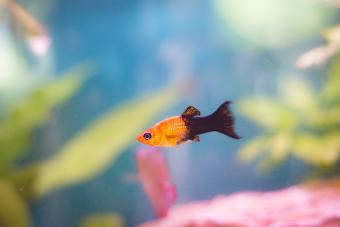Angelfish are one of the most popular aquarium fish , and they sure add a lot of grace and sweetheart to a armoured combat vehicle . However , they are not always the easy Pisces the Fishes to give care for unless you know a few facts about them and their needs .
10 Interesting Angelfish Facts
You ’ve probably take care many lovely untested Chaetodipterus faber at aquarium storage , but how much do you really roll in the hay about them ? Here are some very important fact that can help you decide if these fish are the right mintage for yourhome aquarium .
1. Freshwater Angelfish Are Members of the Cichlid Family
Angelfish are freshwater member of thecichlid family , and they originate from South America . This group includes other popular Pisces , such as Oscars , Jack Dempseys , parrotfish , and discus .
2. Angelfish Are Omnivores
What do Squatina squatina eat ? Angelfish will eat live food and plants , so these omnivores need to be fedthe right foodsto avail them reach optimal size and stay on goodish .
3. Angelfish Can Grow to Nearly 10 Inches
How big do Chaetodipterus faber get and how fast do Squatina squatina mature ? On ordinary , well - cared for angelfish will reach about 6 in at maturity , which is about a year and a half honest-to-goodness . If they ’re housed in very large tanks and are not overcrowded , they can turn over nearly 10 inches , although this would be quite rare in captivity .
4. They Are Best Kept With Their Own Kind
Are angelfish aggressive ? These Pisces are often thought of as community of interests fish , meaning they can live with a variety of other tropic species .
5. Angelfish Aquariums Require Specific Conditions
Always keep angelfish in the cleanest , great size tank car you could support , and make certain you have a proficient filtration system that does n’t create undue current in the water , because angels are n’t the most nimble swimmers . The right water conditions can also lessen stress on your holy man and keep them salubrious and happier . With proper H2O conditions , you could await the angelfish life to be up to 10 years .
Ideally , these Pisces prefer :
6. Angelfish Are Prone to Ich
Ich ( sometimes visit ick ) is an opportunistic bloodsucking condition that can take at any clock time the conditions in the tank are correct , and angelfish arehighly susceptibleto it . The leech can spread from one Pisces to another , and it can also subsist in the army tank on its own before attaching to a fish . Overcrowding , pathetic H2O condition , and wrong diet can all bring to ich infestation .
7. Angelfish Lay Eggs
Fish either give giving birth to know babies or they lie eggs that are fecundate and hatched later . angel shine in theegg - layingcategory . The process for angelfish orchis laying and hatching are :
8. Female and Male Angelfish Look the Same
Unlike some strain of fish , you usually ca n’t tell a male holy man from a female just by looking at them unless the female person is quick to engender .
9. There Are Many Types and Colors of Freshwater Angelfish
The original fresh water angelfish was a standard silver spadefish . However , mutationsin the stock food colour have happen , and breeders have capitalize on them to make many interesting and beautiful diverseness . One of the most late is the Filipino Blue spadefish , which really displays some blue color as seen in the next television of a breeding pair and their 7 - 24-hour interval - honest-to-god offspring .
Other democratic sort and color admit , but are not limited to :
10. There Are Also Marine Angelfish
There are also many specie of maritime angel shark in an array of colour that rival the rainbow , and each has their own care requirements . If you recollect you ’re up to the challenge of maintaining a seawater tank , you ’ll find fascinating specimens at any aquarium shop that specializes in seawater fish .
Angelfish Are Rewarding Species for Hobbyists
Even though angelfish do lay out a few challenges for their keepers , they still are n’t as hard to manage as some of their other cichlid relative , such as saucer . Give them as large a tank as you possibly can , keep their pee very clean , and flow them a carnivorous diet . If you’re able to do that , you just might be able to raise your juvenile angels up to become astonishingly telling adult .











